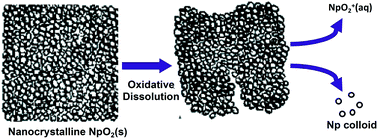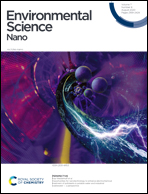Grain boundary facilitated dissolution of nanocrystalline NpO2(s) from legacy waste processing†
Abstract
Dissolution of actinide dioxides, including neptunium dioxide (NpO2(s)), is paramount for the prediction of the environmental fate of nuclear materials. Quantifying dissolution rates, as well as understanding qualitative dissolution mechanisms, informs performance assessment for geologic disposal of spent nuclear fuel and management of legacy radioactive waste. The aim of this research was to measure the dissolution rate of nanocrystalline NpO2(s), produced through legacy nuclear waste processing, under oxidizing conditions, as well as to characterize surface alteration to the material. The solid phase was characterized using electron microscopy techniques (SEM/STEM) and X-ray photoelectron spectroscopy (XPS), indicating preferential dissolution of Np-hydroxide contained in the grain boundaries of NpO2(s) and fragmentation of grains from the matrix. The oxidative dissolution was monitored over 40 weeks, yielding a two-step kinetic dissolution model involving hydration of NpO2(s) and subsequent oxidation and dissolution of the hydroxide phase. The proposed dissolution models for nanocrystalline NpO2(s) suggest that microstructural features such as grain boundaries are key factors affecting dissolution, including release of colloidal particles, and ultimately, environmental fate and transport of nuclear materials.

- This article is part of the themed collection: Environmental fate of nanomaterials


 Please wait while we load your content...
Please wait while we load your content...
